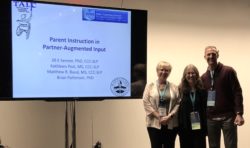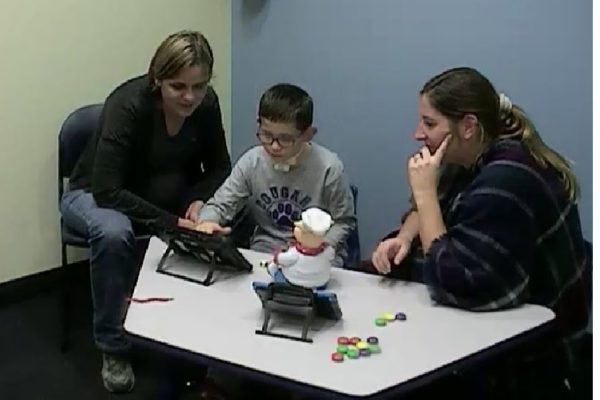PrAACtical Research: Effects of Parent Instruction on SGD Use

As we all know, parents of kids with complex communication needs play a critical role in their children’s learning of communication,  language, and AAC. Today, our guest authors describe an important study that can help us support these families with effective training, practice, and coaching. Jill Senner, Kathy Post, and Matthew Baud describe the study they did on AAC parent training and explain the outcomes.
language, and AAC. Today, our guest authors describe an important study that can help us support these families with effective training, practice, and coaching. Jill Senner, Kathy Post, and Matthew Baud describe the study they did on AAC parent training and explain the outcomes.
Enjoy!
::::::::::::::::::::::::::::::::::::::::::::::::::::::::::::::::::::::::::::::::::::::
In 2018, we wrote about the importance of evidence-based practice in ensuring a high standard of care for our clients and patients. Reading AAC-related journal articles is a great way to both continue developing clinical expertise and stay informed about best research evidence. It can be quite time consuming for busy professionals to regularly read journal articles and keep up with the AAC literature so we’ve been invited back to share a summary of our latest publication with PrAACtical AAC readers.
The article we are discussing today is Senner, J. E., Post, K. A., Baud, M. R., Patterson, B., Bolin, B., Lopez, J. & Williams, E. (2019). Effects of parent instruction in partner-augmented input on parent and child speech generating device use. Technology and Disability, 31, 27-38. DOI: 10.3233/TAD-190228. For those who don’t have library privileges, the full article is available for download via the Technology & Language Center, Inc. website using the link above.
Let’s start with the rationale. Failing to recognize issues important to families can lead to dissatisfaction and device abandonment. One barrier reported by families is lack of knowledge about AAC systems and how to incorporate them into daily life. Fortunately, parent education, also referred to as parent training, has been effective in teaching parents a variety of language and AAC skills.
However, how we teach parents is as important as what we teach them in establishing evidence-based practice. Parent education programs are of greater benefit when parents practice skills on their own children and when training is implemented into everyday, meaningful routines and activities.
Successful parent education programs also include multiple training elements such as those found in Kent-Walsh & McNaughton’s 2005 instructional model:
- Pretest and Commitment to Instructional Program;
- Strategy Description;
- Strategy Demonstration;
- Verbal Practice of Strategy Steps;
- Controlled Practice and Feedback;
- Advanced Practice and Feedback;
- Posttest and Commitment of Long-Term Strategy Use;
- Generalization of Targeted Strategy Use.
 In this study, we used this 8-step instructional model to teach four parents to provide partner-augmented (PAI) on their children’s speech generating devices during core family leisure activities (i.e., “common, low-cost, relatively accessible, and often home-based activities that families engage in frequently” such as having a snack, doing a puzzle, or blowing bubbles [O’Neill et al, 2017, p. 314]).
In this study, we used this 8-step instructional model to teach four parents to provide partner-augmented (PAI) on their children’s speech generating devices during core family leisure activities (i.e., “common, low-cost, relatively accessible, and often home-based activities that families engage in frequently” such as having a snack, doing a puzzle, or blowing bubbles [O’Neill et al, 2017, p. 314]).
After attending an initial in-service style session where parents completed parts of steps 1-5, parents attended 8 or 9 weekly 55-minute coaching sessions with opportunities for strategy demonstration, controlled practice and advanced practice.
The results were exciting. All parents demonstrated the ability to perform all of the components of successful PAI (slow rate, model, respect and reflect, repeat, expand, stop) as determined by review of an observation checklist completed during coaching sessions. Parents
significantly increased the percentage of utterances modeled on their children’s SGDs between pretest and post-test measures. The percentage of unique words modeled (i.e., type-token ratios) by each parent suggested variety in models at post-test rather than just highly repetitive and stereotyped models. Three of four child participants demonstrated increases in unique words used following parent instruction.
Parents reported liking the “positive environment for learning the process.” “I appreciated the hands-on approach – getting the chance to see it and then jump in and try it yourself.” In addition, they found value in the breakdown of modeling steps and feedback received. They perceived changes in themselves including greater confidence and proficiency in using their children’s devices. They also noticed changes in their children as well such as independently reaching for an SGD and using an SGD more.
What are the implications for clinicians? Evidence-based parent instruction results in changes in both parents and children and should be routinely provided as an intervention when children first receive an SGD.
:::::::::::::::::::::::::::::::::::::::::::::::::::::::::::::::::::::::::::::::::::::::::::::::::::::::::::
Jill E Senner, PhD, CCC-SLP is a speech-language pathologist with over 20 years of experience working with children with complex communication needs. She is the owner/director of Technology and Language Center where she specializes in providing augmentative and alternative communication (AAC) and assistive technology (AT) services including assessment, consultation and training, and workshops/lectures. Dr. Senner has presented at numerous national assistive technology conferences and has taught graduate courses in AAC and swallowing disorders. She has published research in the areas of AAC, siblings and disability, and swallowing disorders in cerebral palsy.
Kathleen Post, MS, CCC-SLP is an Associate Professor and Clinic Coordinator at Midwestern University’s Speech-Language Institute, with duties that include clinic administration, supervision and teaching in AAC. Prior to joining MWU 5 years ago, Kathleen worked as the Director of AT, Speech/Language and Nutrition Departments at a large pediatric outpatient rehabilitation center in Illinois. Kathleen’s areas of interest and research include pediatric speech and language disorders, AAC and assistive technology for persons of all ages and disabilities.
Matthew R Baud, MS, CCC-SLP, has been working with AAC for over 15 years. He currently is the Assistive Technology Coordinator at Niles Township District for Special Education (NTDSE) performing evaluations, trainings and coaching communication partners. Matthew also has his own AAC private practice working with individuals with complex communication needs from birth through adulthood. He is an adjunct professor at Saint Xavier University where he teaches a graduate course in AAC and has presented at national and state conferences. Matthew has published research in the areas of AAC.
Filed under: Featured Posts, PrAACtical Thinking
Tagged With: AAC partner training, parent training
This post was written by Carole Zangari




